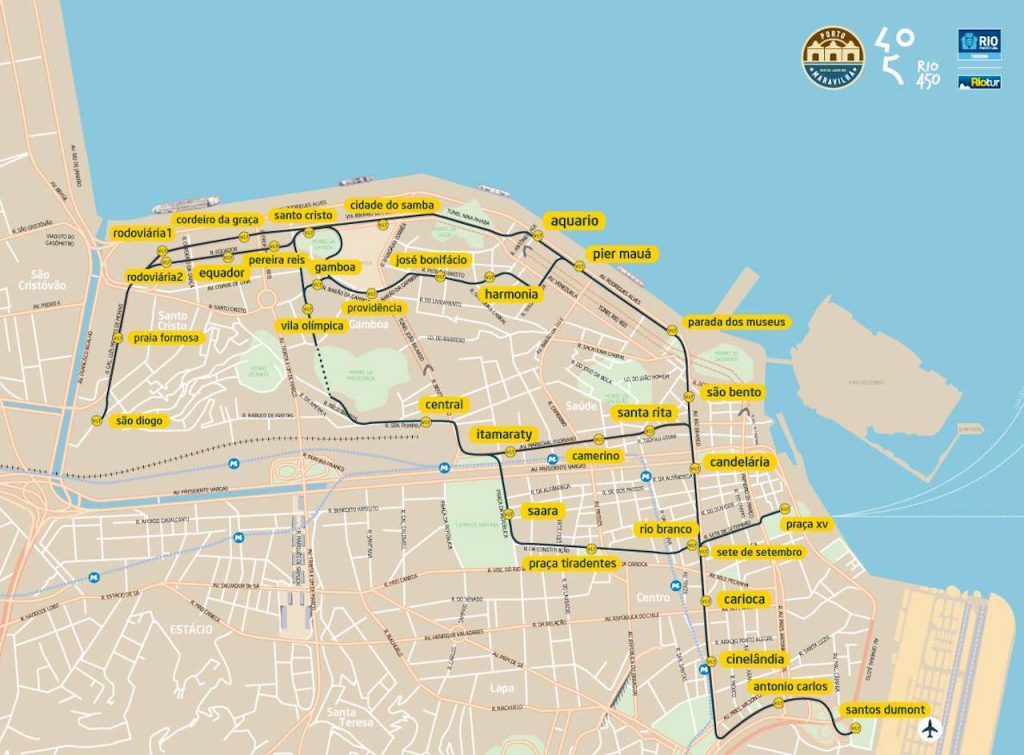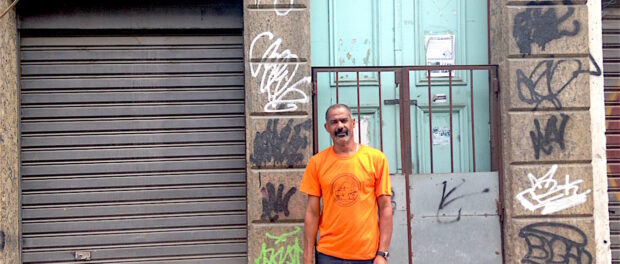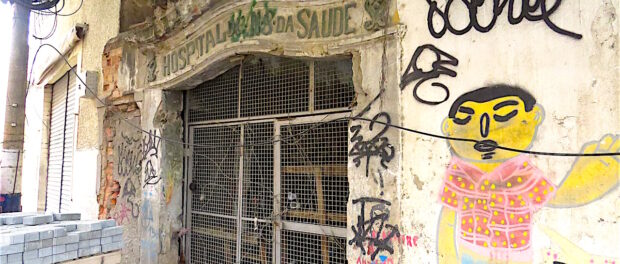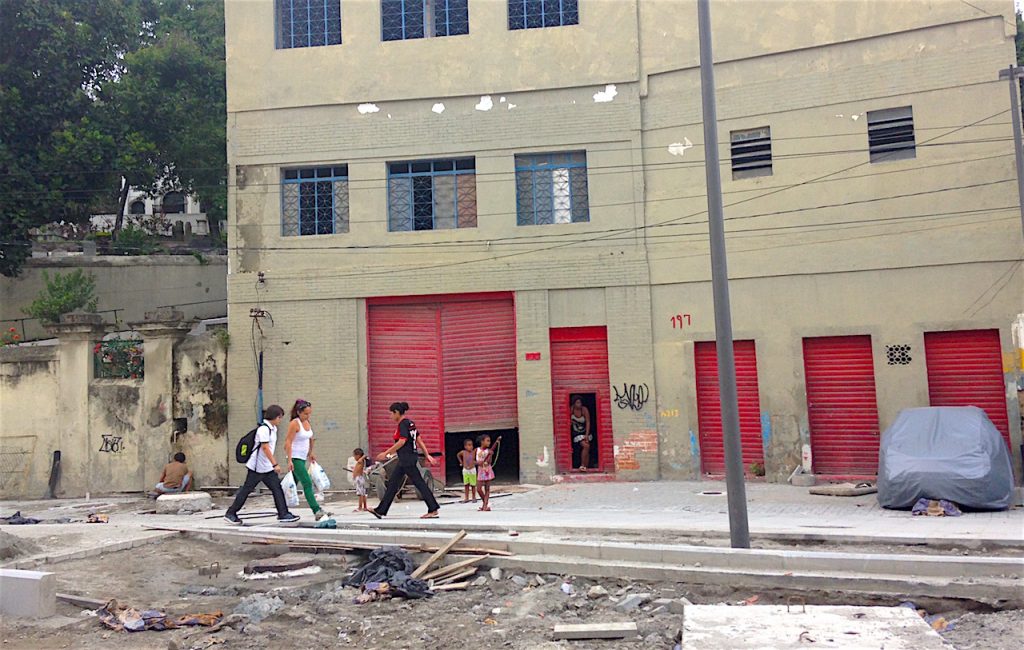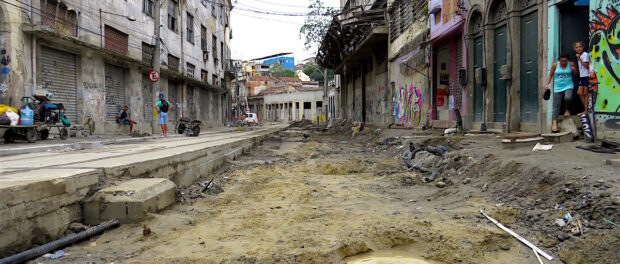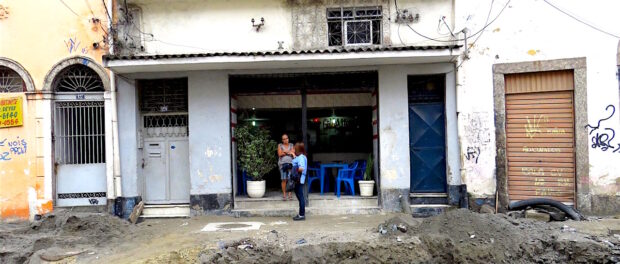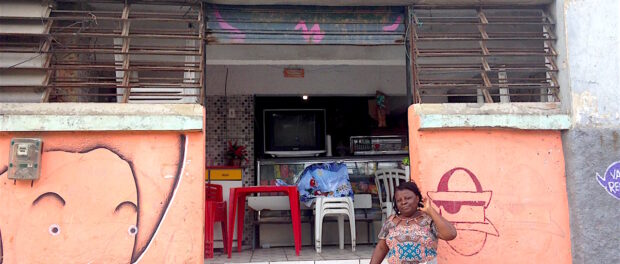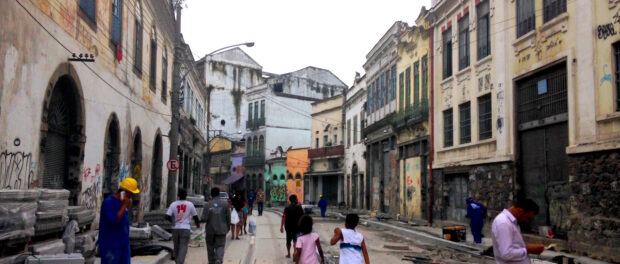
In 2013, construction for the Veículo Leve Sobre Trilhos (VLT) or Light Rail System, led by Rio’s Port revitalization program, Porto Maravilha’s (Marvelous Port) VLT Carioca Consortium, began throughout Rio de Janeiro’s Port and downtown area, with the aim of promoting tourism and redeveloping the historic, but neglected Port region. Three years later, many of the six lines of the VLT are still under construction, with only Line 1, which connects Rio’s central bus station with Rio’s domestic airport Santos Dumont, in full operation. When construction for the VLT is completed it will cut through Rio’s historic central neighborhoods of Gamboa, Saúde, Santo Cristo, and past the favelas Providência, Pedra Lisa, Moreira Pinto, and São Diogo, and sections of São Cristovão, Centro, Caju, and Cidade Nova.
Although the first main line of the VLT has now been completed, much is still under construction, specifically within the neighborhood of Gamboa, home to the most residents in the region. Priority was given to the completion of the VLT Line 1, as it passes through the newly renovated Olympic Boulevard and past the Museum of Tomorrow and stops by Rio’s Municipal Theater in Cinelândia. The lines passing through the historically black neighborhood of Gamboa, past the New Blacks Cemetery where over 30,000 slaves were buried and Rio’s Little Africa, are left under construction.
With constant delays and minimal communication from the government, the residents of Santo Cristo, Gamboa, and Saúde have endured living within the chaotic, dangerous, and dirty VLT construction site, which has both severely constricted their mobility, businesses and livelihood within the neighborhood for the past three years.
The funding and management of the VLT
When looking at the amount of government spending that went into the Porto Maravilha redevelopment project and specifically the VLT Carioca Consortium, the lack of value given to the improvement of the region’s schools, hospitals, historic buildings, and housing is apparent.
In 2009, the Porto Maravilha project was launched by the city of Rio de Janeiro, promoted as an opportunity to finally redevelop the long neglected Port Region. The project called for using private investments to finance the redevelopment project to minimize government spending through the use of public-private partnerships (PPP), making this the first PPP within the city of Rio de Janeiro, as well as the largest PPP ever to be passed in the country.
Before the activation of this project, the redevelopment of the area had been focused on affordable and participatory housing plans, through the Ministry of Cities. Although conversations and plans emphasizing the importance of social housing and infrastructural investments had been in the works amongst policy agents since the 1980s, the launch of the Porto Maravilha redevelopment project resulted in movement away from that emphasis of social inclusion and instead marked a movement towards the privatization of this area. With the project’s launch, the focus of redevelopment was shifted towards PPPs, real estate speculation and tourism, and the control of development was put into the hands of CDURP, a legacy planning agency headed by a former real estate developer, and the private companies involved.
The privatization of the port area is apparent to the president of the Gamboa Neighborhood Association, Eduardo Souza: “Today we know the situation is that privatization is valued more than residents.”
The PPP responsible for the construction and management of the VLT was signed in June 2013 establishing a partnership between the Rio de Janeiro city government and the VLT Carioca Consortium.
The VLT Carioca Consortium is composed of the Grupo CCR, Invepar, Odebrecht TransPort, RioPar, Benito Roggio Transporte and RATP Dev Brasil.
Although the PPP behind the Porto Maravilha and the VLT Carioca Consortium was advertised as a way for the government to be able to spend less money on infrastructure projects, Mariana Werneck, researcher at the Metropoles Observatory, in her study titled “Porto Maravilha: Agents, Power Coalitions and Neoliberalization,” asserts that the government actually ended up investing more money into the PPPs than the private companies themselves, contrary to the City’s rhetoric.
Werneck asserts that the actual amount of government spending in the VLT project has not be accurately disclosed by the City. Although the Public Policies Plan of the 2016 Olympic Legacy Plan–created by the municipal, state, and federal government together with the Public Olympic Authority (APO) and the Rio 2016 Committee–reports contributing R$532 million through the PAC Mobility Program, the Public Policies Plan did not include the amount spent by the Rio city government. In the VLT Carioca Consortium contract it is written that the City will pay R$1.6 billion to the private companies that make up the VLT Carioca Consortium for 25 years following the completion of the project.
The government advertises that 42.6% of the funds in the PPP come from the public and that 57.4% comes from private participation, however Werneck argues that actually 63.19% comes from public funds and only 36.81% comes from private companies. The PPP contract authorized the VLT also has a clause that protects the private company so that in the event they do not meet their monthly revenues the city of Rio is subject to pay the difference in losses for 25 years. Essentially, Werneck’s research shows that there are a group of private companies operating without any financial risk or regulations and without obligation to improve the life of residents in the region.
Eduardo Souza expressed that what the community really needs is investments from the government in education, housing, health and the restoration of historic sites.
VLT impacts on residents’ lives
To make way for the construction and implementation of the VLT, many bus lines were cut. For the past three years, residents have been forced to navigate the construction sites and lack of bus lines to get to work, school, or the homes of their friends and families. An increase in mode options has not yielded increases in mobility.
Eduardo Souza stated: “We have a great difficulty with transportation in the neighborhood. The removal of various bus lines in expectation of the VLT… A lot of people [in the city] have been connected the Olympic Boulevard, to Praça Mauá, but within the neighborhood residents still do not have [the mobility the government] promised.”
Maria José has lived in Gamboa for six years after moving from Bahia to Rio de Janeiro in search of work. She said: “Before this project the bus passed here. It was a direct bus. It was fast. Now, there are no buses… [The VLT] currently does not have any benefits.” Maria also said that even once all the lines of the VLT are running she probably will not use it, as it is a slow form of transportation.
Around 28 bus lines that provided the residents of the Port Region with access to the South Zone and North Zone were cut and 21 lines were shortened to allow for the construction of the VLT. In Gamboa, five lines were removed to make way for the construction, so now residents have to walk through the João Ricardo Tunnel, which is often unsafe, in order to access transport out of the Port Zone. A resident expressed that while bus lines 010 and 011 pass through Gamboa they only run until 7pm.
Another barrier to transportation access in the region was the removal of the Perimetral Highway, demolished in 2013 to clear the view of the Guanabara Bay, to be replaced with two tunnels and an expressway. The expressway and tunnel starting on Rua Rodrigues Alves has been open since July 2016. But while the Perimetral Highway was an important bus route accessible throughout the Port Region, the tunnel and expressway is inaccessible for the area’s residents.
Additionally, in order to make room for the construction of the VLT hundreds of very old trees that provided shade for pedestrians were cut down.
For many of those living in Santo Cristo, Gamboa and Saúde, the doors to their homes and businesses open directly into the tubing, trenches and dirt of the construction site. Residents complain that during heavy rains the construction trenches fill with water which allows mosquitos to breed and enter their homes. One resident mentioned that everyone in his family had Zika because of the increase in mosquitos as a result of the water sitting on the construction site. Maria José reported that people are impeded from leaving their houses as the streets flood with water. She stated that every time it has rained her house has flooded.
Finally, the overall practicality of the VLT as a transport solution for residents is questioned. Many residents say that the infrequency of trains (each one only passing every 15 minutes or more) and the slow speed do not make it an efficient form of transportation.
Local economy affected by the VLT
Construction and implementation of the VLT has not only made it difficult for residents to get around, but has had negative impacts on small local businesses and the informal street vending economy in the region.
One resident and store owner along the line through Gamboa spoke of how the area has changed since construction began in 2013. “No cars pass, there’s only construction. It is difficult for us. There are a lot of merchants here and unfortunately the government does not pay attention to us.”
One business owner who has lived above and managed a restaurant for over twenty years stated that since the construction started the amount of business has greatly declined. “Unfortunately no one is left. Before the start of this construction, I sold 100 meals per day, today I sell one, when I sell one…”
Many small restaurants and businesses in Gamboa have had to close because the three years of work have greatly restricted the flow of pedestrians and completely halted the flow of cars that used to bring customers. One resident pointed to a bar on the corner of Pedro Ernesto Street and said: “The man there is over 50 years old. He is closing his bar because there aren’t conditions to sell food.”
Francisco Dutra is the owner of the Tia Pretinha convenience store, located just around the corner from the start of the VLT Line at the bus station and is a resident of the Novo Ecuador Community Occupation in Santo Cristo, located along the line of the VLT. He stated: “Before, the taxi point was here, so people were buying from us. There were daily customers who took everything from here, and from there it got worse.”
The changes in the flow of traffic, as well as the construction site have made it difficult for street vendors to conduct their business in order to survive. Locia, 64, from Nova Iguaçu relies on selling floor matts to people driving through Santo Cristo for a living. She said that since fewer cars are passing through the area she has had less business. Commenting on the construction of the VLT she stated: “It is good, but for who depends… For the street vender who depends on living off of the street, it’s over. I used to have a stall there on the corner where I sold food. And now I don’t. I earned little, but now my income is even less. For me, who works here, it got worse.”
Maria José explained how buses used to stop at the Praça da Harmonia, a historic square where community members gather. A street vendor of food and beverages, she used to sell most of her goods at the bus stop, but since the construction of the VLT started and the bus lines were cut, she has not been able to successfully sell there anymore.
Maria José also expressed her frustration with the changes in the region. She stated that the Praça Mauá area surrounding the Museum of Tomorrow, one of the major attractions along the VLT line, frequently hosts public events, however the city has cracked down on informal street venders. More people frequent the area, but street vendors in the area cannot access these potential customers. In the Popular Committee on the World Cup and Olympic Games‘ dossier “Rio 2016: The Exclusion Games,” one of the major human rights violations outlined was the repression of the informal economy through 2016 Rio Olympic legacy projects, such as the Porto Maravilha project.
It is unclear when the works of the VLT will be completed, if ever. But the positive impacts for low-income residents of the Port Region are highly questionable. “It only got better for tourists, but for those who live here it is a horror,” said Locia. Although many residents expressed hope for the changes the VLT could bring to the area once completed, the construction and developments so far have had a largely negative impact on those living in the region, giving highest priority to real estate development, private entities, venues, formal vendors, and tourists.

